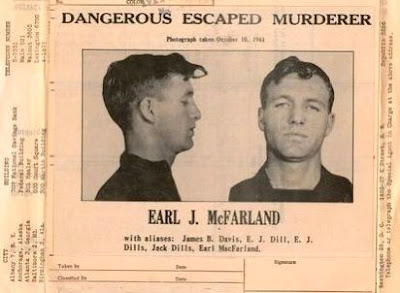Justice at 12:04 A.M.
By Robert A. Waters
June 12, 1979. Midnight. Delaware Correctional Center in Smyrna.
The cold wind snapped Billy Bailey’s jacket as about a dozen spectators watched him trudge up the stairs of a makeshift gallows. Two prison guards escorted him to the platform where his sentence would be carried out. They wore black jumpsuits, black hoods and black baseball caps to hold the hoods in place. Prison warden Robert Snyder, also wearing black, waited near the center of the scaffold. Bailey, about five feet tall and weighing more than 200 pounds, seemed not to notice the noose swinging in the wind. In fact, he never seemed to notice or care about anything, much less the pain he inflicted on humanity during his sordid life.
Mary Ann Lambertson, daughter-in-law of murder victims Gilbert Lambertson, 80, and wife Clara, 73, was one person struggling with mental pain caused by Bailey’s actions. He’d broken into the couple’s modest farm home near Dover and shot-gunned them. Mary Ann, working nearby, heard the blasts and witnessed Bailey fleeing across a fifty-acre field. Racing to the home, she found Gilbert, half his face blown off, and Clara, with gaping holes in her shoulder and abdomen. Her hand had a gunshot wound, too, as if she’d raised it to try to ward off the buckshot tearing into her soul. Even years later, Mary Ann could not forget that wrenching scene.
In the frigid air, Mary Ann spoke to reporters. “I think it’s really past time this [execution] should have come about,” she said. “It’s been too many years. When they know for a fact that someone did something, it shouldn’t take 16 years to execute him.”For most of his life, Billy Bailey had been a terror to almost everyone who came in contact with him. He’d been imprisoned six times, and when he killed the Lamberstons, should have been on a prison work detail. However, he escaped due to a clerical error. Within minutes of going on the lam, he attempted to hold up a liquor store. When the clerk refused to give him money, he tried to shoot her with a .25-caliber pistol. The gun jammed, and he ran from the store carrying a bottle of liquor in one hand and the pistol in the other.
Less than an hour later, Bailey ended up at Lamberston’s Corner.
Gilbert and Clara raised soybeans for a living. Gilbert’s father had farmed the same land and, when he died, the couple inherited his property and home. They raised their children there. Clara liked to make jams and jellies for friends, and both attended church regularly. They were country people with country values. In the scheme of life, it seemed unlikely that they would fall prey to a hardened criminal like Billy Bailey.
Newsman Karl Vick described the execution: “The guards led
[Bailey] onto the trapdoor, placed a strap around his ankles and pulled a black
hood over his head and upper chest. The noose was fastened over the hood and
tightened beneath Bailey’s chin.
“Several times, Snyder felt at the hood to be certain that the top of the hangman’s knot lay beneath Bailey’s left ear, the placement old Army regulations specify to assure the straightening rope has the best chance of bringing quick death by severing the spinal cord. Finally, the warden stepped back and pulled a gray wooden lever with both hands.
“The trap door opened with a thump. Five feet of manila rope followed through the hole and snapped taut 10 feet above the sodden ground.”
Guards quickly placed a canvas tarp in front of Bailey, hoping to conceal the body as it spun in the wind. As friends and relatives of the victims watched, their thoughts may have drifted back in time to a loving couple who had lived ethical lives and died violent deaths. Dennis Lambertson, grandson of the victims, certainly had those thoughts. “One of them watched the other one get blown away,” he said. “They were kind of old, feeble people. My grandfather kind of wobbled when he walked.”
Billy Bailey chose hanging over a poison needle, which was his right at the time he committed the murders. He is said to have commented, "I don't want to be put down like a dog." There will be no more hangings in Delaware since, by law, any new execution will be done by lethal injection.
Whatever anyone thinks about the death penalty, Billy Bailey has never hurt another person since that cold night in June.
NOTE: Much of the information for this story came from the excellent Washington Post article, “An Execution in the Old Way,” by Karl Vick. I also consulted court documents and numerous newspaper articles from the period.






